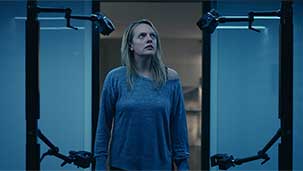No one obsesses over someone’s invisible movements as much as you do. It’s your job to anticipate where someone could be and remember all their previous steps in order to see the full picture, even when others can’t. All made possible by some fancy new cameras.
Maybe Elisabeth Moss was stalking you in preparation for this role.
Moss’s character in The Invisible Man is the victim of an abusive ex-boyfriend who gets inside her head, and eventually, her bedroom, without anyone else understanding how he could be so ever-present in her life. This is a Blumhouse thriller, not a purely psychological drama, so the villain is also a world-leading optics pioneer capable of such (literal) invisible stalking. But science is the last thing on writer and director Leigh Whanell’s mind. He made a genre film with an agenda. Basically, It Follows so Get Out of A Quiet Place. And The Invisible Man actually belongs in the conversation with those titans of new wave horror.
While you were tracking technical details, making sure that shots stitch together and track character movement, Whanell’s script has its sights set on the big picture. As a result, The Invisible Man is the first truly great film sprung from the #MeToo movement (apologies to Bombshell, The Assistant, Support the Girls, et al.). It delivers all the visceral suspense and thrills one expects from this type of outing, with a healthy dose of the female glare (what I’ll call the distrustful reaction to the infamous “male gaze”). By locking the audience's perspective to that of the victim, we experience first-person terror that feels miles apart from the pervy voyeur-o-vision we’ve come to expect from Hollow Man or the Translucent anti-superhero from “The Boys” TV series. It’s not just refreshing in a politically woke sense, it’s actually more effective as a film.
Much to your delight, I'm sure, (and mine) the film isn’t trying to impress anyone with a floating fedora and sunglasses. Enough is withheld visually to almost believe, for a while, that maybe Moss’s character is going over the deep end, paranoid without real justification. The title of the film, of course, vindicates her from the start, but Whanell doesn’t let that prevent us from experiencing some skepticism ourselves as she seems to unravel. Until, of course, the shark comes out of the water and she has to face the terror head on.
In fact, the final act of the film proves as adept of an accomplishment in action filmmaking as the early part of the film is patient and deceptive with negative space. This transition in filmmaking styles doesn’t seem like it should work, but in practice it is wildly effective. I guess sometimes you just have to see to believe.
Watching out for you,
Christopher







